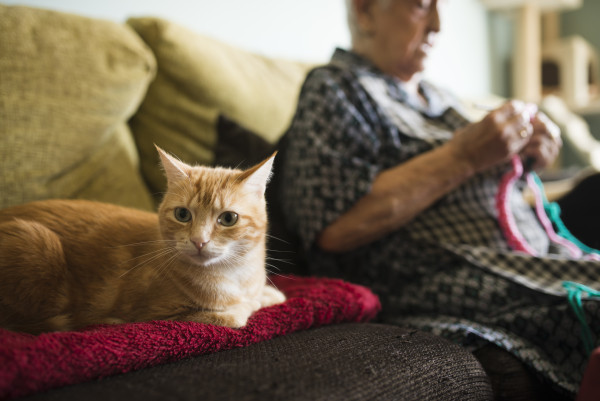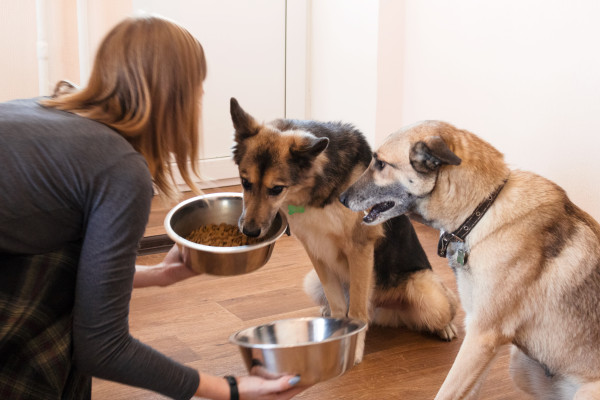
A Life Well Fed: Meeting the Nutritional Needs of Pets at Every Stage
Today’s dogs and cats are living longer than ever thanks to 21st-century advancements in nutrition and veterinary care. The rise of preventive care for both humans and pets has ushered in a new era where pet parents no longer wait until their pet displays a problem to seek support; now, they anticipate health issues and invest in products to help prevent them.
Generally, a pet goes through three stages of life: growth, adulthood, and seniority. The growth phase begins at birth and lasts until a pet has reached skeletal maturity, at which point it becomes an adult. During this time of early development, many pet owners feed puppy- or kitten-specific diets, recognizing their pets’ unique nutritional needs during this foundational stage of life. For adult pets, maintenance diets—essentially any diet that isn’t specific to growing pets or vet-prescribed for a particular health condition—aid in providing the right nutrients at the right ratios to support overall health and wellness. As they age into the senior stage, pets experience many of the same challenges as aging humans—metabolism slows, the ability to repair damaged cells diminishes, and bodily systems begin to break down. Feeding a diet specifically designed for aging pets can support their health and comfort as they undergo these changes.
It's important to note that while established nutritional profiles exist for growth diets and maintenance diets, there is currently no such profile for senior diets. In general, senior diets are formulated to support more targeted nutrition—providing geriatric pets with less of what they don’t need (like fat and calories), and more of what they do (like functional nutrients). Yet, what that looks like can be highly variable with no standard definition.
Regardless of whether your pet is a puppy or kitten, an adult, or entering their golden years, ensuring their health and wellness is supported at every stage of life is crucial. However, understanding when these transitions occur and how best to support them can be confusing for pet owners.
Let’s explore why this is the case and how the industry can foster a more comprehensive understanding of life-stage nutrition among pet parents.
Size Matters
According to a survey conducted by Purina in 2020, nearly half (47%) of small-breed dog owners didn't realize their dogs needed to be fed a puppy-specific diet for up to a year, and a whopping 92% of large-breed dog owners weren’t aware their dogs may need to be fed puppy food for up to two years.
This is ultimately because size matters. Generally, small-breed dogs age more slowly than larger breeds, but they mature more quickly in the earliest stages of life. For example, small-breed puppies typically reach their full adult size in a few months to a year, while a large-breed puppy doesn’t reach it for a year or two, even if both were born on the same day.
While there are a variety of different domestic cat breeds, they are generally around the same size, making it easier for cat owners to determine when to transition from a kitten-specific diet to an adult maintenance diet. According to Purina, once a cat reaches 12 months of age, it’s typically time to make the switch. However, Maine Coons and other large breeds may benefit from eating kitten food for a few months longer than their smaller counterparts.

Photo by Olga_Ovcharenko
Those Golden Years
On the other end of the age spectrum, the concept of senior pet food has become more prevalent in recent years. According to a 2022 survey by Packaged Facts, more than half of US dog and cat owners have a senior pet. Yet, there are still pet owners who never make the switch to a senior diet, despite their pets’ potential to benefit from these diets to support their health and well-being as they age.
For dogs, the question of when they are considered a senior is just as convoluted by breed size as it is for determining the jump from puppyhood to adulthood. The age at which dogs are considered senior varies by breed and size, with toy breeds considered senior at 9 years, small breeds at 8 years, medium breeds at 7 years, large breeds at 6 years, and giant breeds at 5 years.
For cats, once they reach the age of 10, they are, by and large, considered senior. This, again, varies by size, and many veterinarians will begin looking for signs of aging around 7 years old. As a cat ages, they could benefit from more tailored life-stage nutrition.
Put That In Dog Years
Dogs have distinct nutritional needs that change throughout their lives. Puppies require higher levels of protein, fat, and calories to support rapid growth and development. Balanced—and tightly controlled—ratios of calcium and phosphorus are also key, particularly in large-breed dogs to prevent skeletal developmental issues. In contrast, adult maintenance diets are designed to maintain optimal weight and health, with nutrient levels that support overall well-being.
As dogs age, their nutritional needs shift. Senior dogs may benefit from diets that are tailored to their individual needs. Aging dogs undergo a range of changes that can impact their health, including a decrease in energy requirements. One study found a 25% decrease in energy needs in 11-year-old dogs compared to 3-year-old dogs of the same breed. This decrease in energy needs can contribute to weight gain if not addressed through dietary adjustments. Additionally, aging dogs may experience a decline in cognitive function, joint health, and immune system function.
To support healthy aging, senior dog diets can include adequate protein levels to maintain lean body mass, reduced fat and calories to prevent weight gain, and added nutrients, such as medium-chain triglycerides (MCTs), to support cognitive function. Omega-3 fatty acids, such as eicosapentaenoic acid (EPA) and docosahexaenoic acid (DHA), can help support joint health and mobility. Antioxidants and probiotics can also support immune system function, digestion, and overall health.

Photo by westend61
Purr-fect Timing
The same concept of life-stage nutrition is true for our feline friends. Kittens require protein-rich, high-fat, and calorie-dense diets to fuel their rapid growth and development (and their zoomies). Young kittens should be fed three to four meals per day that include elevated levels of DHA and EPA, which are crucial for brain and retina development.
As kittens mature into adult cats, their dietary needs shift to focus on maintaining their health and preventing age-related issues. Adult cat food typically has fewer calories, moderate protein levels, and may include added nutrients to support urinary health, coat condition, and immune function, helping to support weight management, diabetes care, and address other common feline health issues.
Much like dogs, cats’ nutritional needs change as they age. During these later years, changes in activity levels, metabolism, and digestion can affect body weight, lean body mass, the immune system, the digestive system, and the skin.
Adult cats often become overweight due to reduced energy needs, and their diets should include reduced fat and calories to minimize weight gain. In contrast, senior cats may experience weight loss and reduced ability to digest fat and protein. At this stage, a highly digestible diet can help maintain lean body mass and ideal body condition.
As cats age, they slowly lose lean body mass, with some losing up to a third of their muscle mass by the age of 15. To combat this, senior cat diets should prioritize adequate protein content to maintain lean body mass, with a focus on easily digestible sources. Additionally, a diet higher in essential fatty acids, prebiotic fiber, and antioxidants (such as vitamins C and E) can support an aging immune system and overall health. Feeding highly palatable senior cat diets can help stimulate appetite and encourage proper nutrient intake, particularly as some cats experience a decline in appetite with age.
In general, timing is everything. As pet owners and veterinarians observe a pet age in real-time, it’s important to keep their nutrition in mind. For example, if a pet starts noticeably slowing down with age, even if they don’t fall neatly into the life-stage categories explained above, it may be time to seek a diet intended to support cognition, reduce oxidative stress, or maintain lean muscle mass. All pets are unique, and while there are important trends to watch in our pets’ aging processes, they will look different for every pet—and therefore, demand an intervention best suited for them.
Starting In-Store
Pets+ Magazine recently surveyed US pet retailers and found that many are calling on brands to deliver more life-stage-specific formulations for puppies, kittens, and senior pets. Associates at independent pet retail establishments from coast to coast iterated their desire for more proactive education around life-stage nutrition from brands, with some highlighting the need for suggested aging timelines to help them in educating their shoppers, products that address cognitive support, and a wider range of senior products for aging cats.
Jennifer Larsen of Firehouse Pet Shop in Wenatchee, Wash., said her store would benefit from “Something that could follow the pet parent for the life of the pet… I think the products are there; it’s educating people to start them before it’s too late.”
Herein lies a wealth of opportunity for brands and retailers to provide this kind of education. One way this can be achieved is through tools that educate pet owners on breed-specific aging, such as signage throughout the store and age-related product placement.
Another key area to address is staff training on the nutritional differences between young pets, adult pets, senior pets, and the formulas that support them, so they can best recommend the foods that meet the life stage of each pet. Even educational flyers and e-mail newsletters that keep customers informed about their pets’ changing nutritional and care needs. How cool would it be to receive a postcard with a coupon to visit and discover the diet that meets your pet's changing needs when it’s the right time?
However, when asked if they currently track their customers’ pets’ ages, 81% of independent pet retail associates reported that they do not. Further, 81% of respondents also noted they do not currently target different pet age groups with promotions and deals on products and services. Consider this the low-hanging fruit!
Taking this one step further, pet retailers could use digital portals, QR codes, or in-store kiosks to assist pet parents in creating profiles for their pets. Understanding a dog or cat’s age, weight, lifestyle, and other details can help retailers track their customers’ evolving needs and empower them to provide ongoing, personalized recommendations on which food to feed or which product to explore. It can also help pet parents identify nutritional issues, such as obesity, early on, allowing for more timely intervention and potentially increasing the pet’s lifespan. Additionally, it would create regular touchpoints for retailers to engage with their customer base and reinforce the importance of meeting life-stage milestones with proper nutrition and care.
But why not take another step further? Brands and retailers could partner to create product and service bundles that grow with the pet, starting from the early days of life, progressing through adulthood, and culminating in senior-specific products. Curated bundles would not only simplify the decision-making process for pets but also foster stronger brand loyalty by serving as a single-point solution in today’s saturated pet care market.
The gist is this—retailers are uniquely positioned at the intersection of consumer trust and product access. By equipping store associates with the knowledge and tools they need, the industry can bridge the gap between what pets need and what their owners understand.

Photo by nadezhdaz
At the End of the Day
While our pets may be living longer these days, longevity alone isn’t enough. What matters most at every age is quality of life. Supporting pets as they navigate each life stage requires more than just good intentions; it demands proper nutrition delivered at the right time and supported by accessible education.
From formulation scientists to brand managers to retail associates, the pet care industry has a role in making life-stage nutrition more transparent, personalized, and actionable for dog and cat owners.
At the end of the day, the onus is on industry professionals to deliver solutions and products that meet pets’ needs as they grow and age, from the first tail wag to the final fetch.
Follow us on LinkedIn for the latest updates on all things happening here at BSM Partners.
About the Authors
Dr. Katy Miller works as the Director of Veterinary Services at BSM Partners. She earned her veterinary degree at Ross University and completed her clinical year at Louisiana State University. She previously served for 11 years as the Director of Dog and Cat Health and Nutrition for Mud Bay where she earned multiple certifications and specialized in pet food nutrition, prior to which she practiced general and emergency medicine for seven years. She is also a competitive three-day eventer, licensed falconer, and claims only two (Golden and Mini Doxie) of their nine dogs.
Dr. Blaire Aldridge is the Vice President of Nutrition Services at BSM Partners. Throughout her career, Dr. Aldridge has been one of the industry’s primary innovators in companion animal nutrition, leading teams at Nestle Purina to groundbreaking products and solutions. She is also an experienced innovator for equine nutrition. Dr. Aldridge received her master’s degree and PhD in monogastric nutrition at Purdue University, and conducted post-doctoral work in human nutrition at Washington University Medical School.
Jordan Tyler is the Director of Media at BSM Partners and co-host of the Barking Mad podcast. She has more than five years of experience reporting on trends, best practices and developments in the North American pet nutrition industry. Jordan resides in Bentonville, Arkansas, with her husband and their four furry family members.
This content is the property of BSM Partners. Reproduction or retransmission or repurposing of any portion of this content is expressly prohibited without the approval of BSM Partners and is governed by the terms and conditions explained here.